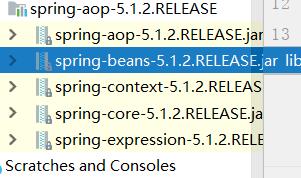Spring IOC基础使用
Posted Mr. Tan
tags:
篇首语:本文由小常识网(cha138.com)小编为大家整理,主要介绍了Spring IOC基础使用相关的知识,希望对你有一定的参考价值。
先下载、导入核心jar包

编写Book类和CollectionUse类

1 package MyPackageOne; 2 3 public class Book { 4 private String title; 5 private double price; 6 7 public Book() { 8 this("", 0.0); 9 } 10 11 public Book(String title, double price) { 12 this.title = title; 13 this.price = price; 14 } 15 16 public String getTitle() { 17 return title; 18 } 19 20 public void setTitle(String title) { 21 this.title = title; 22 } 23 24 public double getPrice() { 25 return price; 26 } 27 28 public void setPrice(double price) { 29 this.price = price; 30 } 31 32 @Override 33 public String toString() { 34 return "title: " + title + ", price: " + price; 35 } 36 }

1 package MyPackageOne; 2 3 import java.lang.reflect.Array; 4 import java.util.Arrays; 5 import java.util.List; 6 import java.util.Map; 7 import java.util.Set; 8 9 public class CollectionUse { 10 private List<String> stringList; 11 private String[] strings; 12 private Set<String> stringSet; 13 private Map<String, String> stringStringMap; 14 15 public List<String> getStringList() { 16 return stringList; 17 } 18 19 public void setStringList(List<String> stringList) { 20 this.stringList = stringList; 21 } 22 23 public String[] getStrings() { 24 return strings; 25 } 26 27 public void setStrings(String[] strings) { 28 this.strings = strings; 29 } 30 31 public Set<String> getStringSet() { 32 return stringSet; 33 } 34 35 public void setStringSet(Set<String> stringSet) { 36 this.stringSet = stringSet; 37 } 38 39 public Map<String, String> getStringStringMap() { 40 return stringStringMap; 41 } 42 43 public void setStringStringMap(Map<String, String> stringStringMap) { 44 this.stringStringMap = stringStringMap; 45 } 46 47 @Override 48 public String toString() { 49 return "CollectionUse{" + 50 "stringList=" + stringList + 51 ", strings=" + Arrays.toString(strings) + 52 ", stringSet=" + stringSet + 53 ", stringStringMap=" + stringStringMap + 54 \'}\'; 55 } 56 }
在applicationContext.xml中写好类实例

1 <?xml version="1.0" encoding="UTF-8"?> 2 <beans xmlns="http://www.springframework.org/schema/beans" 3 xmlns:xsi="http://www.w3.org/2001/XMLSchema-instance" 4 xsi:schemaLocation="http://www.springframework.org/schema/beans http://www.springframework.org/schema/beans/spring-beans.xsd"> 5 <bean id="bookOne" class="MyPackageOne.Book"> 6 <property name="title" value="java"></property> 7 <property name="price" value="15.2"></property> 8 </bean> 9 <bean id="collectionUseOne" class="MyPackageOne.CollectionUse"> 10 <property name="stringList"> 11 <list> 12 <value>帅气的我list</value> 13 <value>勇气的我list</value> 14 <value>厉害的我list</value> 15 <value>无敌的我list</value> 16 <value>666的我list</value> 17 </list> 18 </property> 19 <property name="strings"> 20 <array> 21 <value>帅气的我string</value> 22 <value>勇气的我string</value> 23 <value>厉害的我string</value> 24 <value>无敌的我string</value> 25 <value>666的我string</value> 26 </array> 27 </property> 28 <property name="stringSet"> 29 <set> 30 <value>帅气的我set</value> 31 <value>勇气的我set</value> 32 <value>厉害的我set</value> 33 <value>无敌的我set</value> 34 <value>666的我set</value> 35 </set> 36 </property> 37 <property name="stringStringMap"> 38 <map> 39 <entry> 40 <key><value>name</value></key> 41 <value>无敌</value> 42 </entry> 43 <entry> 44 <key><value>你好啊</value></key> 45 <value>enen</value> 46 </entry> 47 </map> 48 </property> 49 </bean> 50 </beans>
主函数中观察获取结果:

1 ApplicationContext ac = new ClassPathXmlApplicationContext("applicationContext.xml"); 2 Book bookOne = (Book) ac.getBean("bookOne"); 3 System.out.println(bookOne); 4 CollectionUse cu = (CollectionUse) ac.getBean("collectionUseOne"); 5 System.out.println(cu);

以上是关于Spring IOC基础使用的主要内容,如果未能解决你的问题,请参考以下文章
